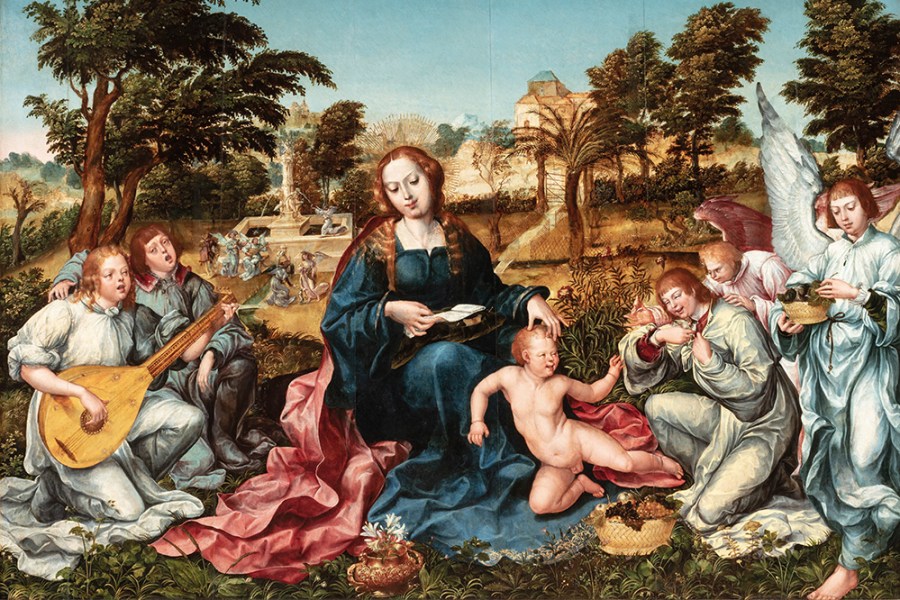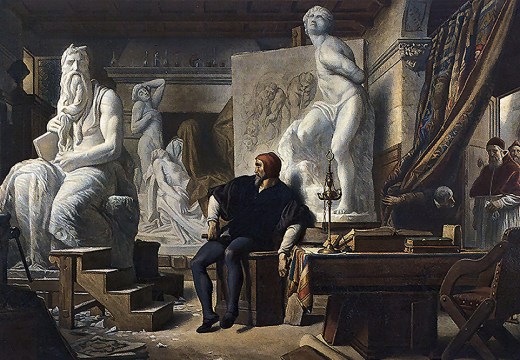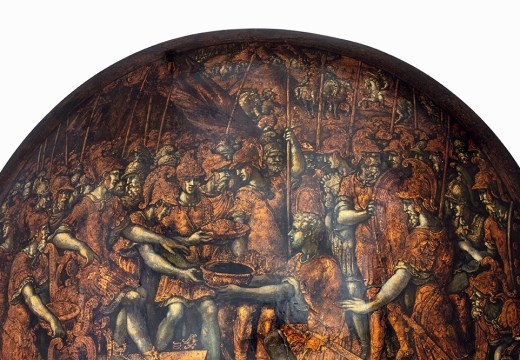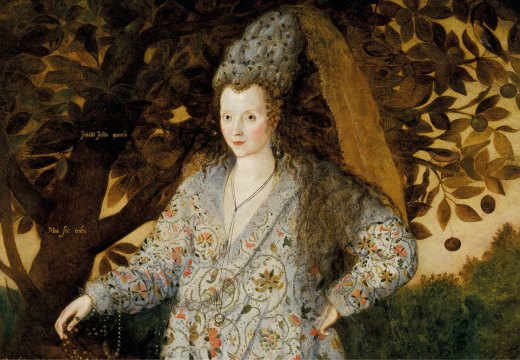From the September 2022 issue of Apollo. Preview and subscribe here.
If you were to set side by side the earliest and latest paintings in ‘The Golden Age of the Portuguese Renaissance’ at the Louvre, you might be tempted to read them as symbols of Portugal’s transformation over the seven decades the exhibition covers. The first, an almost monochrome full-length depiction of Saint Vincent by Nuno Gonçalves, painted in around 1470, is spare to the point of stringency. The almost-naked saint, tied to a column inside a bare stone chamber, looks impassively into the middle distance. The last, The Virgin and Child with Angels, painted in 1539 by Gregório Lopes, offers an Edenic vision of abundance, the young Christ capering with angels in a walled garden surrounded by fruits and flowers while an Italianate fountain gushes in the background.
Portugal in 1470 was far from becoming ‘queen of the oceans’, as it was characterised in the following century by the artist and art historian Francisco de Holanda. Its mariners were still edging along the coast of Africa; it would be another three decades before Vasco da Gama rounded the Cape of Good Hope and landed in India. In contrast, by the late 1530s the quaysides of Lisbon were teeming with peoples from Asia, Africa and the Americas, while the city’s markets brimmed with camphor and nutmeg, gold and ebony, silk and sugar.
But even before the famous feats of navigation immortalised by Luís de Camões, the country ‘where the land ends and the sea begins’, in Camões’ words, was turning outward. Lisbon had become a way station on the maritime route from the North Sea to the Mediterranean, while the royal house of Aviz, on the throne from 1385, had married into the ruling dynasties of England, Spain and Austria. However, the key relationship was with the Low Countries. Antwerp was the largest port in northern Europe, and many of the goods that landed in Lisbon originated from there. It was from the Low Countries, too, that the seeds of Portugal’s artistic flowering came.
Remarkably little Portuguese painting survives from before the 15th century; rarer still are the names of Portuguese artists practising at this time. When Jan van Eyck appeared at the Portuguese court in 1428 to paint Princess Isabella, fiancée of his patron Philip the Good, Duke of Burgundy, he must have created quite a stir. Artistic links between Portugal and the Low Countries increased in the decades that followed. In the middle of the century, Isabella donated a triptych by Rogier van der Weyden to the monastery of Batalha. Successive Portuguese kings invited Flemish painters to their courts, while in Antwerp sugar grown in Madeira was traded for painted altarpieces. The triunity of commerce, art and royal patronage is illustrated vividly in an episode involving the Flemish-born painter Francisco Henriques, who in 1512 was sent by Manuel I to the Low Countries to sell a consignment of pepper, the proceeds of which were to subsidise his purchase of art materials and recruitment of apprentices.

Hell (c. 1510–1520), anonymous painter. Museu Nacional de Arte Antiga, Lisbon; © DGPC/ADF, Luísa Oliveira / José Paulo Ruas
The influence of the Low Countries is inescapable in the paintings in this exhibition, even those by native Portuguese artists. In The Good Shepherd (c. 1520) by Frei Carlos and The Adoration of the Shepherds (1515) by Jorge Afonso, for instance, the devotional subjects are framed by blue-tinted landscapes reminiscent of Joachim Patinir’s canvases. Two works by the artist known as the Master of Lourinhã depicting episodes from the life of Saint James and another, Hell, by an unknown artist, have much in common with the mystical and macabre phantasmagorias of Bosch and his imitators. The Visitation (1520) by Lopes and Jorge Leal contains an elaborate gothic tower decorated in the northern European tradition.
That these paintings should contain common stylistic features is really no surprise, given how tight-knit the painters working at the Portuguese court were in the late 15th and early 16th centuries. This group resembled something between a cartel and a family firm. Henriques was brother-in-law of Afonso, who in 1508 was appointed inspector of royal painting by Manuel I. Afonso was himself father-in-law of Lopes, who was appointed royal painter by Manuel’s successor, João III, and uncle of another artist featured here, Cristóvão de Figueiredo. Afonso used his court position to set himself up as a gatekeeper of Portuguese painting; virtually every artist of significance in the country passed through the massive 56-room house in Lisbon that he bought with the proceeds of his preferment. This was an artistic milieu in which collusion was valued more highly than virtuosity.
Although all of the paintings in this exhibition feature religious themes, the glory of Portugal is as much the true subject as the glory of Christ. The most brazen example comes in a magnificent pair of painted doors commissioned by Eleanor, sister of Manuel I, possibly from de Figueiredo, for a cabinet to house the body of Saint Auta. The internal panels show the saint’s remains, the gift of Emperor Maximilian I to Manuel, being brought out of Cologne towards a waiting caravel, the instrument of Portugal’s maritime expansion. The body is then delivered to the Convent of Madre de Deus, tricked out in Manueline style, in an impressive procession. The external panels depict the marriage of Saint Auta’s mistress, Saint Ursula, to Prince Conan. If anything, they are even more lavish. The celebrants are arrayed in the latest court fashion, right down to the jewels and headpieces. A troupe of Black trumpeters – a feature of Manuel’s court, too – hails the newlyweds from a gallery.
However, some artists were more ambivalent about the new ascendancy of Portugal. It is hard not to read the extraordinary Hell, in which the sinners are force-fed coins by monstrous creatures, as an implicit critique of empire. One demon wears an African-style mask and pouch; another sports the feathered headdress of the Tupi of Brazil. To be sure, such depictions were hardly flattering to the native peoples now brought within the compass of Lisbon’s rule. But, the anonymous artist seems to be saying, to the Portuguese who ventured among them could only come corruption.
‘The Golden Age of the Portuguese Renaissance’ is at Musée du Louvre, Paris until 10 October.
From the September 2022 issue of Apollo. Preview and subscribe here.
Unlimited access from just $16 every 3 months
Subscribe to get unlimited and exclusive access to the top art stories, interviews and exhibition reviews.














![Masterpiece [Re]discovery 2022. Photo: Ben Fisher Photography, courtesy of Masterpiece London](http://www.apollo-magazine.com/wp-content/uploads/2022/07/MPL2022_4263.jpg)
It’s time for the government of London to return to its rightful home